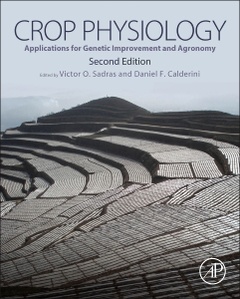Description
Crop Physiology (2nd Ed.)
Applications for Genetic Improvement and Agronomy
Authors: Sadras Victor, Calderini Daniel
Language: English
Subjects for Crop Physiology:
Keywords
abiotic stress; agriculture; agronomic innovations; aquaporins; barley; biomass; biotechnology; breeding; breeding programs; breeding strategy; canopy photosynthesis; China; climate change; conservation agriculture; critical N; crop adaptation; crop characteristics; crop environments; crop modeling; crop physiology; crop production; crop responses; crops; development; drought; eastern and southern Africa; ecology; ecophysiological modeling; ecophysiological models; efficiency increase; environment; environment characterization; environment class; environment type; environmental characteristics; environmental control; evolutionary-trade-off hypothesis; farming systems; fertilization strategy; field-based approach; flower; food production; food security; fruit; genetic control; genetic improvements; genetics; genomic selection; genotype; genotype-environment interaction; GM crop; grain composition; grain yield; growing conditions; growth; G × E interaction; harvest index; heat stress; high potential yield; hydraulic conductivity; ideotype; impact; input-use efficiency; interaction; interdisciplinary approach; land use; leaf; legumes; low rainfall; lupin climate change; maize; managed environment; management; management practices; Mediterranean sites; mega-environment; model crop; modeling; molecular markers; multienvironment trial; N fertilizer; next-generation sequencing; nitrogen allocation; nitrogen fertilization; nitrogen fixation; nitrogen nutrition index; nitrogen uptake; nitrogen-use efficiency; nitrogen; northern agriculture; oil composition; phenology; phenotype; phenotyping; photoperiod; physiological determinants; plant breeding; plant genomics; potato; protein composition
Approximative price 111.43 €
In Print (Delivery period: 14 days).
Add to cart564 p. · 19x23.3 cm · Hardback
Description
/li>Contents
/li>Readership
/li>Biography
/li>Comment
/li>
From climate change to farming systems to genetic modification of organisms, Crop Physiology, Second Edition provides a practical tool for understanding the relationships and challenges of successful cropping. With a focus on genetic improvement and agronomy, this book addresses the challenges of environmentally sound production of bulk and quality food, fodder, fiber, and energy which are of ongoing international concern. The second edition of Crop Physiology continues to provide a unique analysis of these topics while reflecting important changes and advances in the relevant science and implementation systems.
Contemporary agriculture confronts the challenge of increasing demand in terms of quantitative and qualitative production targets. These targets have to be achieved against the background of soil and water scarcity, worldwide and regional shifts in the patterns of land use driven by both climate change and the need to develop crop-based sources of energy, and the environmental and social aspects of agricultural sustainability.
PrefaceAcknowledgements1. Crop Physiology: applications for breeding and agronomyPart 1: Farming Systems2. High yield maize-soybean cropping systems in the U.S. corn belt3. Farming systems of China: Innovations for sustainable crop production4. Improving farming systems in northern Europe5. Raising productivity of maize-based cropping systems in Eastern and Southern Africa: Step-wise intensification options6. Cropping systems in high yielding potential environments. Opportunities and challenges in Southern Chile7. Cereal yield in Mediterranean-type environments: challenging the paradigms on terminal drought, the adaptability of barley vs wheat and the role of nitrogen fertilizationPart 2: Carbon, water and nutrient economies of crops8. Quantifying crop responses to nitrogen deficiency and avenues to improve nitrogen-use efficiency9. A Darwinian perspective on improving nitrogen-fixation efficiency of legume crops and forages10. Senescence and crop performance11. Improving Water Transport for Carbon Gain in CropsPart 3: Genetic improvement and agronomy12. Genetic and Environmental Effects on Crop Development Determining Adaptation and Yield13. Characterising the crop environment – nature, significance and applications14. Model assisted phenotyping and ideotype design15. Crop phenotyping for physiological breeding in grain crops: a case study for maize16. Breeding challenge: improving yield potential17. Improving grain quality. Ecophysiological and modelling tools to develop management and breeding strategies18. Integrated views in plant breeding: from the perspective of biotechnology19. Integration of biotechnology, plant breeding and crop physiology. Dealing with complex interactions from a physiological perspective20. Crop modelling for climate change impact and adaptation
Agronomists; plant geneticists and plant breeding professionals; crop physiologists, ecologists, and ecophysiologists; plant physiologists
Secondary:
horticultural scientists; those involved with grain and cereal crops and sustainable agriculture; environmental microbiologists
Tertiary:
Students of plant breeding and crop ecophysiology
Dr. Daniel Calderini is a full professor of the Plant Production and Plant Protection Institute of Universidad Austral de Chile since 2002. He has specialised in the Physiology of Crops and Cereals. Dr. Calderini was distinguished with The People's Republic of China Friendship Award. He is Coordinator of the Network "Sustainable Intensification of Extensive Crop Production of the Ibero-American Program of Science and Technology for Development. He was the head of the Graduate School and the Doctorate Program of the Faculty of Agricultural and Food Sciences. His physiological research was carried out on pea, lupin, rapeseed, sunflower and quinoa in addition to temperate cereals.
- Provides a view of crop physiology as an active source of methods, theories, ideas, and tools for application in genetic improvement and agronomy
- Written by leading scientists from around the world
- Combines environment-specific cropping systems and general principles of crop science to appeal to advanced students, and scientists in agriculture-related disciplines, from molecular sciences to natural resources management




